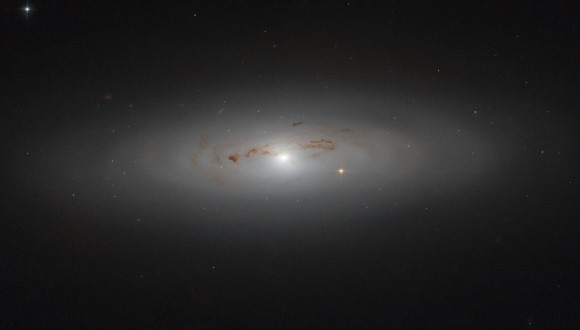The striking image of NGC 4036 is surprisingly scientific
Recently, the Hubble Space Agency's Hubble telescope (NASA) captured a striking image of NGC 4036, a lens-like galaxy that delighted science.
Galaxy NGC 4036, also known as LEDA 37930, UGC 7005 or IRAS 11588 + 6210, is classified as a lens galaxy. It is located in the constellation Ursa Major, about 80.2 million light-years away.
This galaxy belongs to the LGG 266 galaxy group, in the same form as NGC 4041, IC 758, UGC 7009 and UGC 7019.

Image source: Phys.
Previously, NGC 4036 is known for unusual dust lanes that form a spiral pattern swirling around the center of the galaxy.
The galactic core is surrounded by a large flow of hot air and dust, extending out into space and creating many dim light.
The nucleus of this galaxy is classified as a low-level nucleus (low nuclear ionization), which means it can produce extremely low special emission lines in the spectral environment.
Interestingly, on July 23, 2007, an SN 2007gi supernova was discovered by Japanese amateur astronomer Koichi Itagaki near the central bulge of the galaxy NGC 4036.
- How much is the science of 'ignorance'?
- Video: The unprecedented image of the Sun
- Hong Kong: UFOs appear with thunder
- Research on the image of Ig Nobel prize winner 2018
- Stunned by the decoded scientific phenomena
- Animate the space whale image
- Photos of melting ice are surprisingly beautiful but startling
- The image of Centaurus A -
- Browse images in web format with 'HTML Image Browser'
- Explaining the photo
- There is a solution to split the mirror image on the image
- The computer increases the resolution for the image under the microscope
 Van Allen's belt and evidence that the Apollo 11 mission to the Moon was myth
Van Allen's belt and evidence that the Apollo 11 mission to the Moon was myth The levels of civilization in the universe (Kardashev scale)
The levels of civilization in the universe (Kardashev scale) Today Mars, the sun and the Earth are aligned
Today Mars, the sun and the Earth are aligned The Amazon owner announced a secret plan to build a space base for thousands of people
The Amazon owner announced a secret plan to build a space base for thousands of people